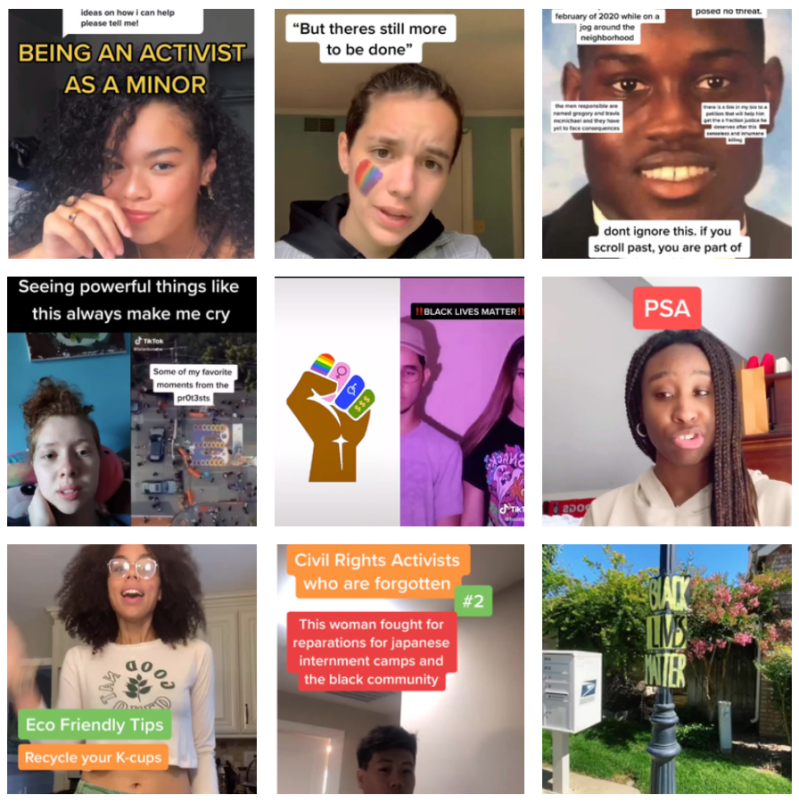To the tune of a “This Is America” / “Congratulations” mashup, Dyllen Nellis ’23 (@imdyllen) displays her artwork about systemic inequalities exacerbated by the COVID-19 pandemic on TikTok. In the comment section, users express their approval with compliments of “love this” or the awe-faced emoji.
Nellis is one of many Stanford students — and people around the world — who are using TikTok, a social media app where users can post short videos paired with audio, as a platform for activism.
Dyllen joins Linda Denson ’23 (@thelindaden) and Malavika Kannan ’23 (@angryymal), a contributing writer for The Daily, in activism on the platform. In one video, Den introduces and elaborates on Black Stanford traditions such as “Black Love” and “Black Frosh Convocation,” criticizing Stanford’s “traditions” as speaking only to white students. In another, Kannan offers free college essay services to those who donate to Black-led organizations or bail funds.
Creators on the platform noted that they, like many, had joined TikTok initially for fun before pivoting to creating activist content.
“When I first started, I made it a priority to only do it for fun,” wrote Taylor Cassidy (@taylorcassidyj) in a statement to The Daily, a digital creator with over 1.7 million followers on the app. “Like many teens, I’ve had struggles with social media anxiety in the past, so with TikTok I promised myself that I would not make it stressful or forced.”
Stanford students echoed similar sentiments: Dyllen, who downloaded TikTok “just for fun,” wrote in a statement to The Daily that she joined the platform having been a fan of the now-defunct app Vine. Several of her friends have also gained “quite a following.”
Yet in light of recent events surrounding the COVID-19 pandemic, the Black Lives Matter movement and the upcoming presidential election, many creators — particularly those of the younger generation — are using their TikTok platforms for activism. Just last month, a plan to inflate the attendance expectations at President Trump’s Rally in Tulsa gained attention and participation due to the widespread sharing from TikTok users.
TikTok differentiates itself from other social media platforms through its algorithm that allows for the simple and fast sharing of content through features like trending hashtags and the “for you” page.
Program in writing and rhetoric (PWR) lecturer Harriett Virginia-Ann Jernigan — who joined TikTok after her students had mentioned and used it in her course — said TikTok’s content-creating features that allow users to collaborate with each other makes it easy to generate entertaining and succinct content.
For instance, duetting, which places two videos next to each other, enables “a kind of dialogue that one does not see anywhere else,” according to Jernigan. Jernigan also credited videos that record people’s bigoted behavior in public as effective in spreading awareness about the “incredibly pervasive nature” of discrimination.
Taylor’s platform focuses on educating others about “Black History and Racial Issues,” often through a skit format or through duetting other creators. This allows her to disseminate information in short periods of time, making it easy for her viewers to “take a lesson away from it without committing to reading a long caption or following a link to a different website.”
“I’ve been invested in Black History since I was a little girl, so it was natural that I bring it to TikTok,” Taylor wrote. “The racial issues persisting in America today are a reflection of how long we’ve been shouting for change.”
For Dyllen, TikTok allows her to support activism by sharing her artwork with others outside her direct circle of friends and allowing her to collect donations via commissions for art.
“I know that people like to turn their art into TikToks, and I know that I’m constantly making art, so I thought why not?” said Dyllen.
While the app has become an emerging platform for activism, it has also been criticized for potentially suppressing in-app activism. Just recently, the company was accused of “shadow banning” videos with the Black Lives Matter hashtag, which was later attributed to a glitch.
In a progress report released by TikTok on June 24, the company announced initiatives to help “users feel safe and heard.” Efforts include the formation of their Creator Diversity Collective, the welcoming of Mutale Nkonde to the Content Advisory Council, whose research helps understand racial biases in the algorithm, and a dedicated page about Juneteenth. However, creators still feel that the company needs to do more.
“They still have a long way to go,” wrote Taylor. “I’ve seen many of my friend’s activism content get taken down for no reason and many users spread hate on their videos.”
Jernigan wrote that if TikTok does not implement the change wanted by their users, users may turn to another platform for activist efforts.
Despite claims of in-app suppression, users are still using the platform for engaging in activism: The increasingly popular phrase “the revolution will be TikTok-ed” reflects the potential for TikTok to become the primary platform for activist efforts.
“The people of this generation will not be silent,” wrote Taylor. “Because of this, we have decided to take the “revolution” into our own hands and use all that we can to spread it; in this case, we use the biggest platform we dominate: TikTok.”
Ultimately, the future of activism on TikTok seems to lie in the hands of the young generation; after all, a majority of TikTok users are Gen Z-ers. As Jernigan wrote, “I defer to younger people truly driving this movement, because they are leading in an entirely new way.”
Contact Sophie Wang at sophie.my.wang ‘at’ gmail.com.
